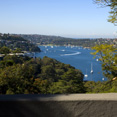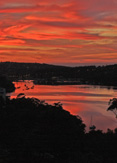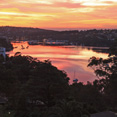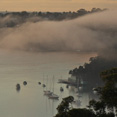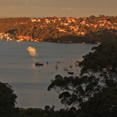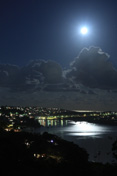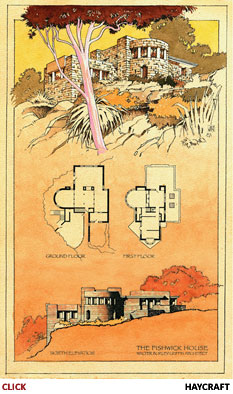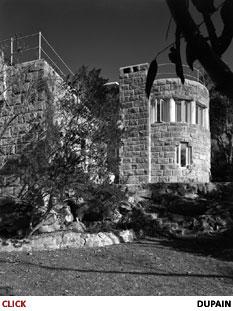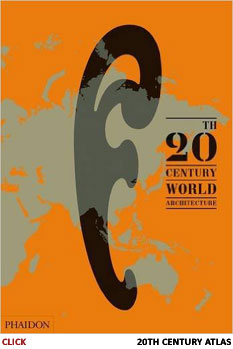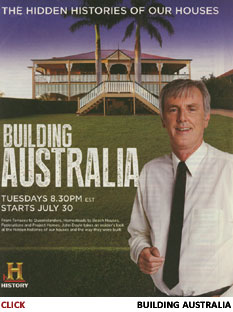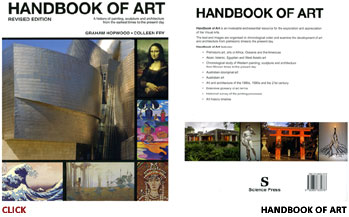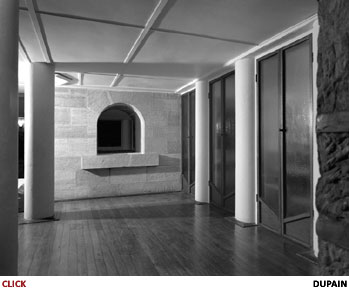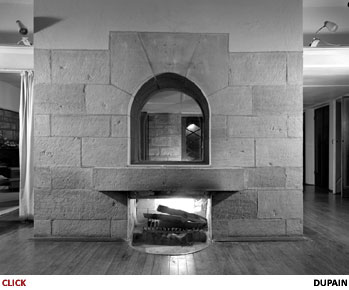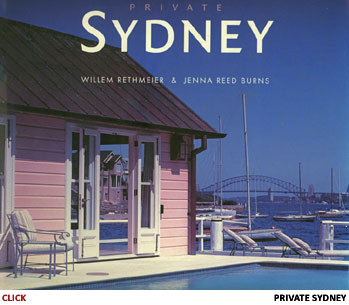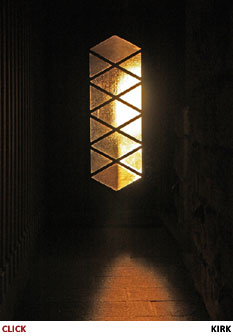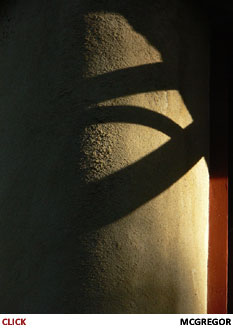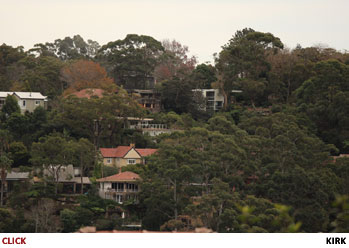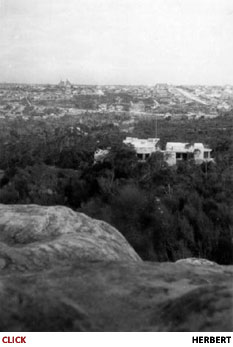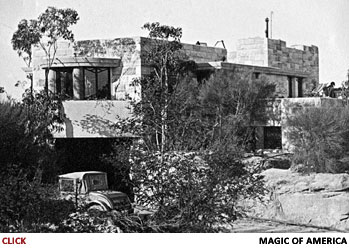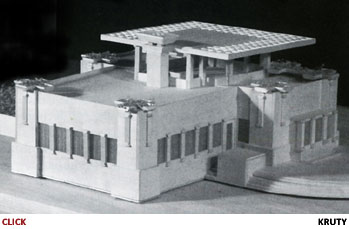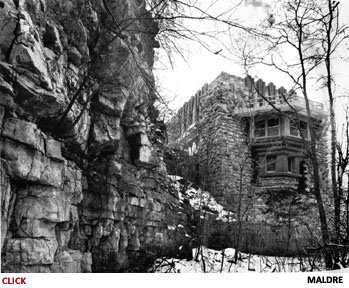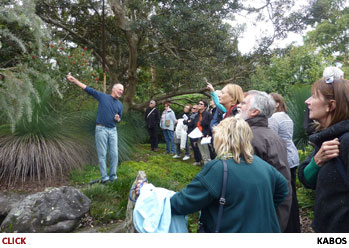Overview of this Section
The Fishwick house is amongst the most important of the almost 200 buildings created by Walter Burley Griffin during his 37-year career in America, Australia and India. It is held in the highest regard by academics and other specialists in the fields of architecture, landscape architecture and design as well as by related professional associations and heritage authorities. Further, since its mid 1990s restoration it has emerged as being amongst the foremost examples of his work, being featured in a large number of books, magazine articles, documentaries and other media addressed to the general public.
The second part of this section examines the reasons for this celebrity. It is, in fact, a relatively recent phenomenon. The house certainly had its critics and was ridiculed - a mortgage assessor even described it as “freakish”. It was also in a very poor state of repair before its fortunes were reversed in the mid 1990s by the restoration of the house and its surrounding landscape. This led to the increasing recognition of its importance beyond being simply a widely listed heritage building. Three factors have contributed to this, all previously unexplored: the unparalleled extent to which the house demonstrates Griffin’s creativity, technical inventiveness and innovative architectural and design skills, its central place in the birth of modern architecture in Australia and its emergence as the prime conduit or vehicle in introducing Griffin’s ideas to a broad audience.
“Most Celebrated”
Since then, there has been a remarkable development in Australia of interest in the house, not only in academic, heritage and professional circles but also among those in the general public who appreciate modern architecture, good design and effective community development. Following its mid 1990s restoration the house has been featured in 15 widely distributed books, four glossy magazine supplements, chosen as the setting for four TV and two radio documentaries, illustrated prominently in two major museum exhibitions and appeared in many journal, magazine and newspaper articles. This interest has not just been confined to Australia.
Internationally, it was chosen to illustrate Griffin’s work in an authoritative, UK produced book on the world's best 20th century architecture, described below, and has been featured in a number of books published in the US and Germany on the Griffins' place in the history of architecture. See the Books & Media section for details. The following five examples have been selected to illustrate the variety and scope of this exposure:
| •Television documentary. The six-part TV documentary Building Australia was produced by the History Channel with assistance from the Australian National Trust and funded by Screen Australia’s National Documentary Programme. The series was first screened on cable television and later on free-to-air channels by the ABC - the country's national broadcaster. The presenter of the series was John Doyle, one of the country's best-known and popular media personalities. It “uses the history of individual houses as a way to explore the architectural and social history of Australia”. The Fishwick house was chosen to represent the period in the early 20th century when architecture was transitioning from being derivative of overseas styles or schools to become truly Australian. The house exemplifies Griffin’s important role in introducing modern, fresh creative thinking and use of new technologies as well as his “visions for the Australian residential community”. To view an extract from this series open .mp4 Video Clip from "Building Australia" [3] |
|
• Photography. Twenty-one professional and specialist photographers, artists and cinematographers have worked in the house including Australia’s most famous photographer, Max Dupain. They have assembled distinctive portfolios of its exterior, interior, native garden and surrounding landscape. For brief outlines of each of their approaches to architectural photography and examples of their work in the house see the Images of House section.
Reasons for Prominence
It is reasonable to ask how the Fishwick house has come to be in the forefront of Griffin's most notable buildings, especially since it does not always make a favourable impression on people who first see it from the street. Its street front is certainly unusual; first-time viewers might describe it as strikingly different, intriguing or perhaps imposing, but they might also wonder how such a building could have come to generate such a level of attention. There are three main factors which have prompted this: its capacity to demonstrate Griffin's technical inventiveness and creative skills, the important place it holds in the birth of modern architecture in Australia and its emergence as the conduit or vehicle by which Griffin’s ideas and principles are introduced to a non-specialised, broader audience.
• Showplace for Griffin's inventiveness and creativity. The house allows visitors to appreciate the virtually unaltered mature work of Australia’s first internationally acclaimed architect built not long before his untimely death. Its extraordinary appearance, unusual and atmospheric interiors and the nature of its relationship with the landscape have made it a prime residential showplace for his innovative and creative talents.
The Fishwick commission gave Griffin one of his last opportunities to fully express his firmly-held ideas on what constitutes good architecture and landscaping. He delivered a building with exceptional architectural qualities owing nothing to traditional styles. Certainly in Australia it is the most forceful and dramatic demonstration of his commitment to organic architecture. Its interiors reveal his mastery of space, light, colour and atmospheric nuance and are packed full of highly unusual and intriguing design ideas. As the pre-eminent Griffin expert Professor James Weirick noted, here he delivered his Australian residential showpiece:
“In November 1929, Griffin had a house in construction at Castlecrag which would be the principal expression of [his] approach to domestic design... dramatically sited ...rising from the cut rock-face of the cul-de-sac. In rough hewn sandstone and reinforced concrete, this two-storey house was at once a citadel and a luxury villa.” [6]
While the house's exterior makes a strong impact as a most unusual building, its interiors are extraordinary with each room having a unique layout and design features. Some of its qualities are less tangible but make a strong impact on the viewer's senses. Examples are the many abrupt ceiling height variations, changes in the intensity and colouring of the available light when moving from room to room and the intrigue of entering the tunnel-like entrance way with its highly unusual repetitive panels of mirrored glass.
| |
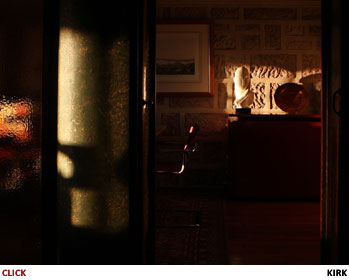 Unexpected view lines and lighting conditions give the house great character. Unexpected view lines and lighting conditions give the house great character. |
● Important role in the birth of Australian modern architecture. The second factor underpinning the significance of the Fishwick house is that it has become emblematic of the emergence of a fresh, distinct and truly Australian architecture. The Griffins arrived in Australia at a time when residential design was very conservative or derivative in style. There were a few Australian architects attempting to react to the winds of change, mainly coming from Europe, but Griffin showed the way to an unashamedly local architecture which was more responsive to local conditions, more self-confident and more “Australian modern”. In the last two decades, his 1929 Fishwick house has emerged as a bold and important symbol of the beginning of that process.
While it seems to be the accepted truth that modern architecture was brought to Australia in the early 1950s by the famous Sydney architect Harry Seidler, a very strong case can be made that it was Griffin who deserves this accolade. Since this is a complex and no doubt controversial subject, it is examined in detail in the .pdf. House as Emblem of Griffin’s Modernity. Its main points are:
• Soon after WWII, four decades after his arrival in Australia, Griffin had become regarded by the country’s most authoritative architectural experts as Australia’s first “modern” architect, some even describing him a “prophet” and a “deity”.
• Griffin was unquestionably modern in outlook. He promulgated the latest ideas from the American Midwest, then a hotbed of “organic architecture” and was also closely involved with the latest ideas emerging in Europe. As early as 1914 he went to Vienna explicitly to meet Otto Wagner who was the figurehead of a group of forward thinking Europeans who rejected established and traditional styles of architecture, mostly against strong resistance. The pair even worked together to plan an international competition for a new parliament house for Canberra, explicitly demanding a building based on modern ideas without any influence of imported or derivative styles.
• Griffin publically rebuked Le Corbusier’s notion that houses should be “machines to live in” because that clashed with one of his own strongly-held principles. In his writings and lectures, Griffin insisted that a house should not only be functional but also strive to create a delightful atmosphere by the use of light, colour, textures and spatial variation. In short, it should appeal to the emotions. Also, slavishly adopting the tenets of any architectural school or tradition was anathema to him. He argued that each house required fresh thinking based on the client’s needs and the form of the landscape. It also had to be in sympathy with its surroundings, nature and the community.
• In recent years many well-respected books, magazine supplements and documentaries intended for general audiences have recognised Griffin’s pivotal role in the birth of modern Australian architecture. Most have chosen the Fishwick house to illustrate this because it provides a vivid demonstration of his introduction of new ideas, his principles of good design and his use of the latest materials and technology. Consequently, the house has emerged as a distinctive emblem of Griffin’s modernity.
• Vehicle to Griffin’s enduring ideas. The third factor underpinning the house's significance is that it is playing an important part in the revival of interest in the Griffins, especially in revealing his views on good architecture to non-specialist audiences. After Walter's death in India and Marion's embittered return to the US Mid-West, the Griffins became virtually unknown for some thirty years. A revival of interest in their lives and works grew slowly during the 1970s and 80s. At first this was confined to academic historians; however from the mid-1990s this revival has gathered pace and is spread much more widely amongst people interested in design, landscaping and community development. For more on this development open .pdf The Griffins' Changing Fortunes. Coincidentally, the fortunes of the Fishwick house have followed a very similar path: initially prominent as Griffin's most lavish and inventive Castlecrag house, it was soon ridiculed and became poorly maintained by successive tenants. Following its restoration by the current owners in the mid-1990s, the house has become the prime vehicle by which non-specialists are introduced to Griffin's ideas. Its decline into obscurity and rise to prominence is detailed in the attachment .pdf House's Changing Fortunes.
As a thoughtful, enquiring young architect rubbing shoulders with some of the most progressive architects of his era, Griffin soon developed a set of concepts on the essentials of good architecture, landscape development and community building. He consistently adhered to and espoused these throughout his career, unlike many other prominent architects. These ideas and principles are increasingly respected and continue to resonate today, especially with students and emerging professionals seeking a philosophic underpinning to their work in order to guide their architectural careers.
Briefly, he believed that a building should respect its surroundings, be designed with regard for nature and the community and relate strongly to the landscape in its siting, form and use of materials. Each design should arise from satisfying specific needs or solving problems, rather than being derivative of accepted styles or architectural schools. Further, in contrast to the emerging European Modernists’ strict adherence to functionality, he believed that good design should influence the viewer’s emotions. For more on his views open .pdf Griffin’s Ideas and Principles.
Because the Fishwick house very effectively captures people’s attention, as well as embodying Griffin's most cherished ideals and illustrating them well, it has emerged in Australia as the prime conduit or vehicle for spreading his beliefs more widely. Since its restoration in the mid 1990s there have been 25 significant Griffin-related productions and events in Australia which were addressed to general, rather than academic audiences. The house and its qualities have been prominently featured in almost all of these. As the attachment .pdf House as Vehicle to Griffin's Ideas shows, in three quarters of them the house plus a few others were chosen to play this role but, significantly, in almost half the Fishwick house alone served to illustrate Griffin's ideas and principles.
Experts’ Opinions
While formal evaluations of listed structures by heritage bodies are generally thorough and well-researched, it is often true that personal value judgements on a particular house by experts such as academics, architectural historians, practising professionals and writers on architecture and design can be more informative. This is because, rather than considering the house in isolation against a set of prescribed criteria, experts are able to make comparative judgements, giving different weights to the various qualities of the house relative to others. Such value judgements are often perceptive and illuminating.
Because the house has been widely described and discussed there has been a variety of interesting statements about its importance and place in the development of architecture, particularly in Australia. To review a selection of these, grouped by subject, open .pdf What Experts & Authorities Say.
Following are statements about the house by four of the most highly-respected Griffin authorities: the most acclaimed academic expert in America, his equivalent in Australia, the biographer and historian who wrote the definitive and award-winning biography on the Griffins, and the Australian Walter Burley Griffin Society which works to protect his legacy and has a particular interest in his Castlecrag houses.
• Paul Kruty is Emeritus Professor of Architectural History in the School of Architecture at the University of Illinois at Urbana-Champaign. He is the author or editor of eight books on the Griffins and their works. He has lectured extensively and presented many academic papers on their place in architecture, especially amongst their pioneering "Prairie School" mid-west American colleagues in the early 20th century. He is also a board member of the American Walter Burley Griffin Society and the editor of its journal. In supporting the house’s listing by the Australian Heritage Commission Kruty stated:
"Because of its design qualities and prominence among the Griffin houses in Castlecrag, the Fishwick house has always had a high level of local significance. Following its restoration, in my opinion, it ranks among the most important Griffin buildings in both the United States and Australia. As a well restored, outstanding example of his residential architecture, I believe it has significance at an international level.” [7]
• James Weirick is Professor of Landscape Architecture, Faculty of the Built Environment at the University of NSW, Director of the university’s Master of Urban Development and Design programme and past President of the Walter Burley Griffin Society of Australia. He is a regular media commentator and presenter, especially on Canberra and Castlecrag. He has spoken and written very favourably about the house on many occasions, considering it “simply one of the best things he did” [8] and "the principal expression of [his] approach to domestic design". [9] In a documentary on the Griffins produced for the Powerhouse Museum, Australia’s most prominent institution of technology and design, Weirick said:
“The houses in Castlecrag were very small except for the Fishwick house in The Citadel which was the only one which had a client with a substantial budget; [it] is a very, very significant house.” [10]
• Alasdair McGregor is a qualified architect, author of several biographies on prominent Australian historical figures and accomplished artist and photographer. (See some of his work in the Images of House section.) In his biography on the Griffins, Grand Obsessions, which won the 2011 National Biography Award, he describes the house as:
“...by far the largest of all the Castlecrag residences, the only one to have been blessed with a substantial building budget...Set in sublime isolation - even by Castlecrag standards...Griffin sited it masterfully...In this house of inventiveness, the dining room even sported the fanciful touch of two overhead fish tanks.” [11]
• The Walter Burley Griffin Society was established in Australia in 1988 by a group of people aiming to promote a better understanding of the lives, ideals, vision and works of the Griffins and to protect Walter's remaining buildings. It brings together residents of the community they created, as well as scholars, architects, urban planners and members of the general public who are interested in the Griffin legacy. The society has an off-shoot in America, maintains an excellent website, publishes a regular journal and has hosted many specialist and public tours. Its latest book, “Visionaries in Suburbia - Griffin Houses in the Sydney Landscape”, devotes ten pages to the house which include a detailed essay and many historic and contemporary photographs. It states:
“Following its careful restoration over many years, the Fishwick house has emerged as one of the most significant and celebrated early 20th century houses in Australia. It stands apart from Griffin’s other houses in Castlecrag in the nature of its relationship to the surrounding landscape, through its size and complexity of design, and because of its many innovative technical and decorative features.” [12]
Every authoritative heritage body in the country, including the relevant organs of the federal, state and local governments, has evaluated and favourably assessed the significance of the Fishwick house. It is one of only six houses from the first half of the 20th century to be both on the Register of the National Estate and listed by the NSW Heritage Council.
National level. As part of the evaluation process for possible listing on its Register of the National Estate, in 2002/2003 the Australian Heritage Commission undertook a thorough assessment of the value of the house. Its lengthy formal report was most positive and explored many different aspects of its significance, considering such elements as its historical, social, aesthetic and scarcity values. In releasing the report, the relevant cabinet minister of the Australian government at that time said of the house:
“The Fishwick house is an inspirational creation and one worth keeping for the generations ahead.” [13]
State level. Soon afterwards, a similar investigative process was undertaken by the NSW Heritage Office as it considered listing the house on the State Heritage Register. Its formal report also stressed the importance of the house in the development of modern architecture in Australia:
“The Fishwick house is aesthetically significant... as its form, massing and architectural and decorative detail demonstrate the distinctive style developed by Griffin and [it is] an excellent example of innovative architecture developed during the inter-war period.” [14]
The NSW Heritage Office's detailed assessment document has recently become very important because it, rather than its national counterpart, now has the prime responsibility for the heritage protection of the house. For extracts from this open .pdf State Heritage Register Report.
Local level. Being part of Griffin’s Castlecrag Estate, the house is also formally heritage-protected at Australia’s third level of government through the Willoughby City Council. This local authority devotes considerable organisational and financial resources to protect and promote heritage items within its provenance. In 2000 an illustrated panel on the house's restoration was mounted in council's chambers; the house subsequently won the council's Heritage Restoration Award.
Non-governmental. The significance of the house has also been recognised by its listing with the major non-governmental heritage and architectural bodies. The level of their interest has been demonstrated by the many tours of the house and its garden which have been organised for their members. Examples of such organisations are the Historic Houses Association of Australia, Sydney Living Museums (previously known as the Historic Houses Trust), the National Trust, the Australian Institute of Architects (previously designated "Royal"), the Australian Association of Architects, the Art Deco Society, the Australian Garden History Society and the Walter Burley Griffin Society.
These heritage, historical, architectural and design bodies all value the house, not only for its historical association with Griffin, but also for its own qualities. Its modern history and the authenticity of its presentation have also been important. The virtually unaltered state of the house, its thorough restoration, its re-established native gardens and the well-protected curtilage have been widely acclaimed. These are often described to their visiting members as providing a rare and most valuable opportunity for appreciating Griffin’s work as he intended it to be: a unique house created for its setting and wholly integrated into the local landscape so that the building, its grounds and the contiguous Griffin-designed reserves and pathways became a seamless whole.
Footnotes in this Section
1. Building for Nature Walker et al 1994. p62
2. 20th Century World Architecture 2012. p33
3. Building Australia 2013. Part 5 of this documentary produced by Screen Australia in conjunction with the History Channel.
4. Handbook of Art Hopwood & Fry 2009. p266
5. Private Sydney Reed Burns 2000. pp74-85. Australian Gardens for a Changing Landscape Reed Burns 2008. pp48-53. Garden Voices Latrielle 2013. pp58-69. 100 Amazing Sydney Homes. Magazine supplement to The Sydney Morning Herald 2003.
6. Walter Burley Griffin - A Re-View Weirick 1988. p11
7. From the testimonial by Emeritus Professor Paul Kruty in his 2002 submission to the Australian Heritage Office supporting the listing of the Fishwick house.
8. Professor James Weirick quoted in Eight Great Houses Allenby 2002. p30
9. Walter Burley Griffin: a Re-View Weirick 1988. p11
10. James Weirick interviewed in film documentary “Castlecrag” produced as part of the Powerhouse Museum’s exhibition Beyond Architecture which ran from July 1998 to May 1999.
11. Grand Obsessions McGregor 2009. pp419-420
12. Visionaries in Suburbia Watson ed. 2015. p94
13. Press release from Dr David Kemp, then the minister responsible for the federal Department of Environment & Heritage 2002.
14. From NSW State Heritage Register report December 2006.

